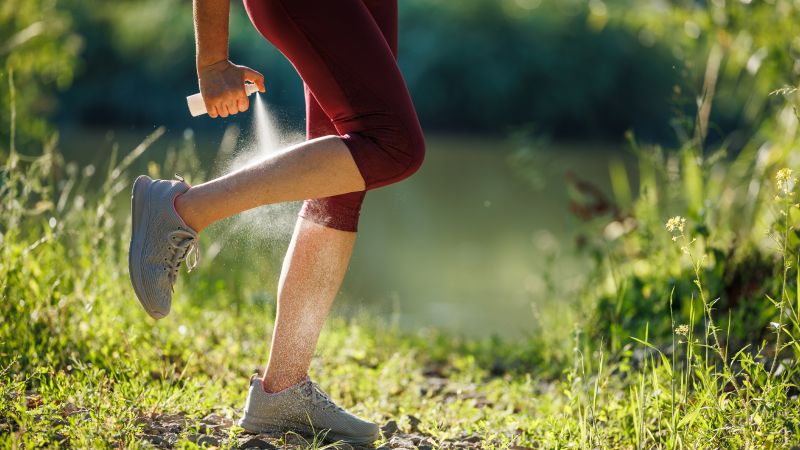Recommended tick repellents
Tick-borne diseases are Doubling Tick populations have skyrocketed in the United States over the past 20 years, making it more important than ever to choose an effective tick repellent when spending time abroad. Outdoor.
These blood-sucking parasites burrow into the skin and can spread dangerous diseases such as Lyme disease, alpha-gal syndrome, and anaplasmosis.
Ticks become more prevalent during warmer weather, so it’s important to apply a quality repellent whenever you’re spending time in nature.
We asked several entomologists for their advice on choosing the most effective repellent, and here’s what they told us:
The U.S. Centers for Disease Control and Prevention (CDC) advises using only repellents that are registered with the U.S. Environmental Protection Agency (EPA).
Check the EPA registration number on the package and Repellent awareness graphicsThis chart shows how long the repellent will remain effective after application.
approved Active ingredients Tick repellents include DEET, picaridin, IR3535, oil of lemon eucalyptus, paramenthanediol, or 2-undecanone.
However, the CDC warns that “lemon eucalyptus oil products and some paramentanediol products should not be used in children under 3 years of age.” Always read product labels carefully for safety information.
“It’s difficult to recommend one or even more than two repellents because different people have different needs,” said Dr. Angela M. Tucker, an expert on vectors and vector-borne diseases at the University of Tennessee.
she, This handy tool Visit the EPA website to choose EPA-registered tick and mosquito repellents.
“The most important thing to remember is to always check yourself when you’re hiking, walking, working, or for any reason you’re outdoors where you might encounter a tick,” she says. “Finding and removing ticks before they can feed on your blood can help reduce your risk of tick-borne illness.”
The most commonly tried active ingredient in tick repellents is DEET. Its effectiveness is unquestionable, but it can damage some plastics and synthetic fabrics. It also has a strong odor that some people find unpleasant, and can make the skin feel oily. It can also be irritating to people with sensitive skin.
A non-greasy, odorless alternative is a synthetic substance called picaridin, which has been sold as an insect repellent in the United States since 2005.
“Studies have shown that picaridin is as effective as DEET against ticks,” said Dr. Goudarz Mollaei, director of the Tick and Tick-Borne Disease Surveillance Program at the Yale School of Public Health.
“However, picaridin has only recently been on the market, so there is insufficient information about long-term side effects and possible health risks. Ultimately, it comes down to choosing an older, more established product over a newer one,” he added.
Mollaei suggests choosing a repellent with a 30% DEET concentration or 20% picaridin. For children, he recommends choosing one with a 30% DEET concentration or 5% to 10% picaridin.
If you have a tick on yourself, your child or your pet, here is a guide from our experts. How to Remove Ticks safely.
Best tick repellent
It is one of the longest lasting repellents available on the market. The light lotion, which contains 20% picaridin, is effective against ticks and mosquitoes for up to 14 hours. The spray version is effective for up to 12 hours. The bottle is small and convenient for air travel and hiking. The disadvantages of the lotion are that it can get messy if applied on the go, and the concentration of picaridin is too high to be used on children.
Best tick repellent with DEET
This formula contains a recommended 30% concentration of DEET to repel ticks for up to 8 hours, which is 5% more DEET than some less expensive products. Off! Deep WoodsIf you don’t have sensitive skin or don’t mind the pungent smell, DEET is a safe bet, with over 60 years of proven use and plenty of research. Its pump bottle makes it easy to apply and air travel-friendly. Ben’s also offers higher concentrations of DEET, but Kate Chapman, urban entomologist and educator at the University of Nebraska-Lincoln, says, “Higher concentrations of DEET will repel insects for longer, but going above 30 percent doesn’t improve repelling.”
Best tick repellent with sunscreen
This Avon formula is one of the few EPA-approved insect repellents on the market that also combines with sunscreen. It’s also water-resistant, making it ideal for humid, sweaty environments and outdoor sports. It keeps mosquitoes and ticks away for up to 10 hours, but it’s not suitable for children.
Best tick repellent for clothing and gear
This product should not be used directly on the skin. It contains permethrin and is designed to be sprayed on camping and hiking gear and clothing without damaging the material. For items such as tents that are not washed as frequently as clothing, it can withstand up to six washes, or six weeks. Permethrin is classified as a restricted insecticide by the EPA, so follow the directions carefully.
Read the repellent label to determine how often and where the repellent should be applied, and whether it is appropriate for your age and purpose. Always avoid your eyes and mouth, and avoid touching either after application. Wash your hands thoroughly, including before eating.
“When using the spray, don’t spray it directly on your face,” says Jeff Landis, a media and communications specialist at the EPA. “Spray it onto your hands first, then spray it on your face. Spray a small amount around your ears.”
The CDC also recommends using insect repellent. rear Your sunscreen.
“Parents should apply this product to their children, avoiding the hands, eyes and mouth,” a spokesperson for the Ohio Department of Health said.
Mollaei also advises against using mixed insect repellent and sunscreen products on children. “It’s also important to wash children’s skin with soap and water after using insect repellent and returning from outdoor activities,” he says.


